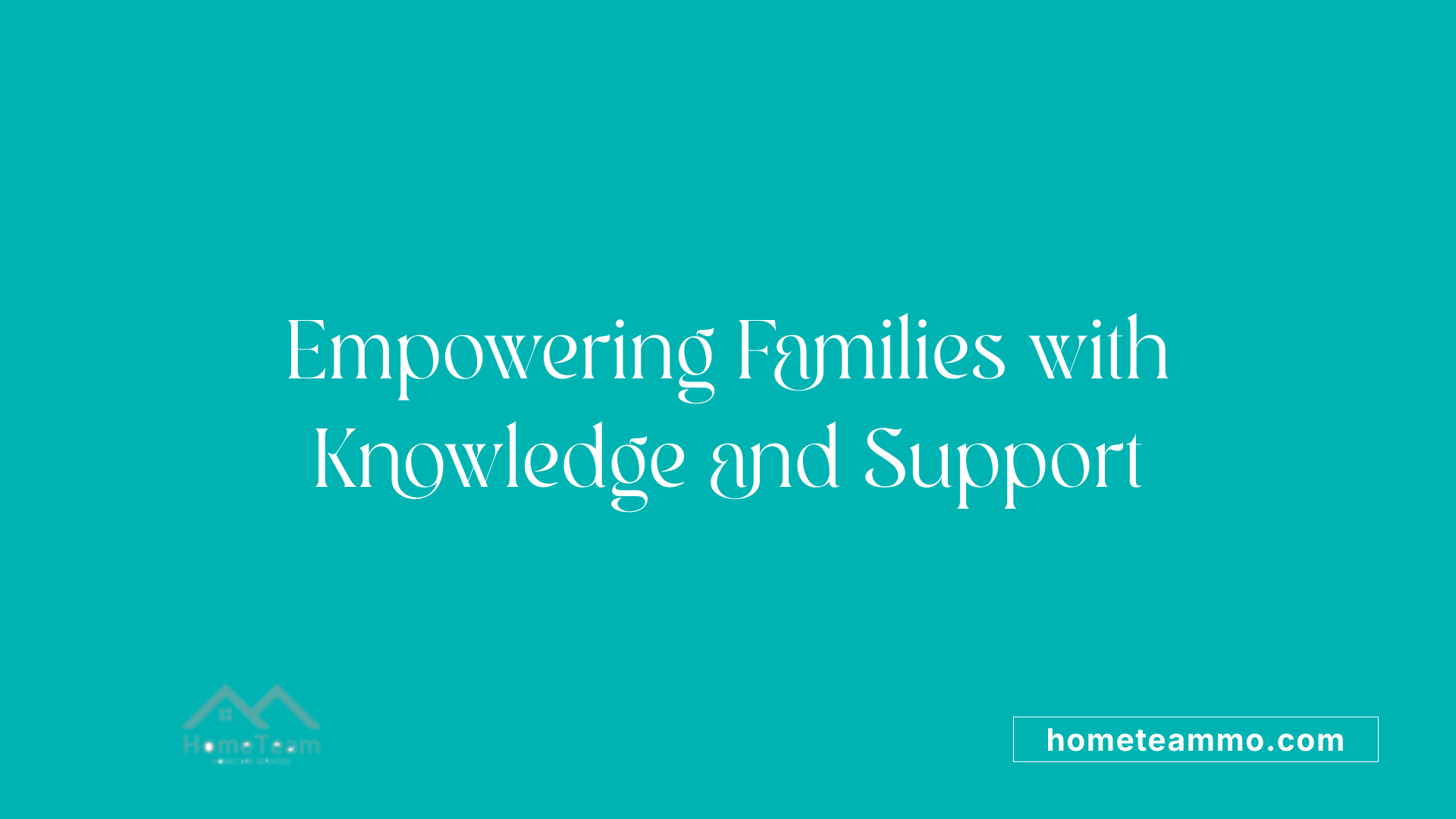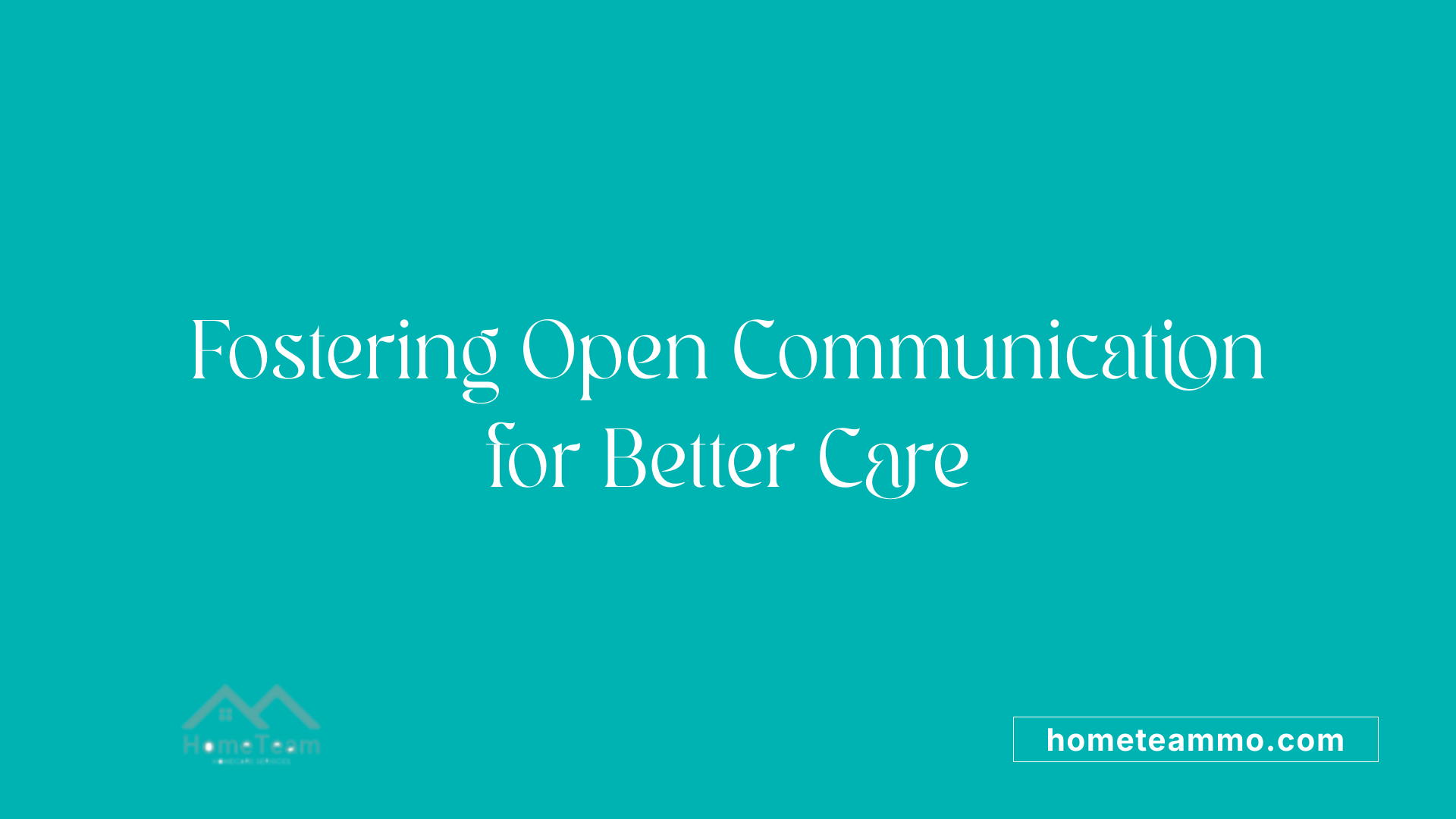How Home Team Helps Families Make Informed Care Decisions
Empowering Families Through Informed, Compassionate Care

Understanding the Role of Home Team in Family-Centered Decision-Making
In healthcare and child welfare, families are at the heart of effective decision-making. The Home Team plays a pivotal role in supporting families by providing resources, guidance, and a compassionate approach that fosters informed, collaborative choices. This article explores how the Home Team facilitates family engagement, promotes resident-centered care, and adopts trauma-informed practices to empower families across various settings.
Family Support as a Foundation for Informed Decision-Making
What are the roles and responsibilities of family caregivers?
Family caregivers play a vital role in supporting loved ones with ongoing health needs, especially older adults and those with chronic disabilities. Typically unpaid, these caregivers are family members, friends, or neighbors who assist with daily activities such as bathing, dressing, medication management, and complex medical procedures.
Their responsibilities extend beyond basic care to include emotional support, navigating healthcare systems, and making important decisions about the individual's wellbeing. With around 44 million caregivers in the US, their unpaid contributions were valued at approximately $257 billion in 2000, highlighting their significance in the healthcare landscape.
However, many caregivers often feel unprepared and lack sufficient knowledge or guidance from health professionals, which can negatively impact both their own health and the safety and quality of care they provide.
Why is support, education, and empowerment important for families?
Supporting families through education and resources is essential for their confidence and competence in caregiving. Interventions such as educational programs, psychosocial support, and respite services have demonstrated effectiveness in reducing caregiver burden, depression, and improving quality of life.
These supports help caregivers manage specific challenges like medication routines, behavioral issues, and sleep disturbances, ultimately enhancing safety for care recipients. Nurses and other healthcare professionals play a crucial role in assessing caregivers’ needs, providing information, and connecting families to community resources.
By empowering families with knowledge, tools, and emotional support, healthcare providers foster collaborative care, which benefits everyone involved. Engaged and well-supported families tend to experience better health outcomes and can make more informed decisions, leading to improved overall quality of care.
What strategies support family-centered decision-making?
Effective family involvement in care decisions is fundamental to quality healthcare. Strategies such as shared decision-making, interprofessional communication, and family engagement tools help bridge gaps between families and care teams.
For example, the Home Team approach incorporates training, clear communication pathways, and relational care, fostering trust and collaborative planning. Additionally, models like Person-Centered Home Care focus on respecting individual preferences and values, leading to reduced hospital readmissions and improved health outcomes.
In child welfare settings, the Team Decision Making (TDM) model involves families and community members in safety planning, reducing unnecessary removals and increasing satisfaction. Incorporating family voices, cultural sensitivity, and transparent processes ensures decisions are fair, inclusive, and supportive.
How does family support link to better health outcomes?
When families are well-informed and actively engaged, they are better equipped to make decisions that promote safety, stability, and wellbeing. Supportive interventions improve communication, reduce stress, and foster stronger relationships between families and professionals.
For instance, in home visiting programs, building trust and providing tailored support allow families to implement strategies during daily routines, leading to enhanced child development and parent confidence.
Overall, investing in family support and education creates a foundation for shared decision-making, leading to higher satisfaction, lower stress, and better health and safety outcomes for patients and families alike.
Strategies for Family Engagement in Care
How do healthcare teams facilitate family engagement?
Effective family engagement is essential for delivering high-quality, person-centered care. Healthcare teams, such as the Home Team, employ a variety of practices to involve families meaningfully in decision-making and care planning.
One prominent strategy is clear and empathetic communication. Teams prioritize understanding families’ perspectives, obstacles they face, and building a relationship based on trust. This open dialogue creates a safe environment where families feel comfortable sharing concerns and preferences.
Another approach involves developing personalized care plans. These plans reflect the values, needs, and wishes of the individual and their family, fostering a sense of ownership and collaboration. Engaging families in shaping treatment strategies ensures that care remains relevant and respectful of their cultural and personal contexts.
Organizational practices also support engagement. Many healthcare settings establish family advisory councils, which include family members in governance and quality improvement efforts. This inclusion helps shape policies and procedures to be more responsive to family needs.
In addition, teams use educational resources and conduct regular check-ins to enhance health literacy and sustain involvement. Tailoring communication methods to be culturally appropriate and easy to understand encourages ongoing participation.
These strategies align with principles of person-centered care, emphasizing respect, shared decision-making, and family empowerment. Supportive policies and a collaborative organizational culture further reinforce engagement efforts.
By implementing these practices, healthcare providers can build stronger relationships with families, leading to better health outcomes, increased satisfaction, and a more holistic approach to care.
| Strategy | Description | Impact |
|---|---|---|
| Empathetic Communication | Building trust and understanding through active listening | Enhanced trust and openness |
| Personalized Plans | Involving families in creating tailored care strategies | Increased relevance and satisfaction |
| Advisory Councils | Including families in governance and policy development | Improved responsiveness to needs |
| Education & Check-ins | Regular information sharing and cultural tailoring | Better health literacy and engagement |
By integrating these methods, healthcare teams foster an environment of partnership that values the family’s role in care, ultimately promoting better health outcomes and stronger connections.
Guidance and Educational Resources for Families
 When facing difficult care decisions, families seek reliable resources and expert guidance to navigate the complex landscape of care options.
When facing difficult care decisions, families seek reliable resources and expert guidance to navigate the complex landscape of care options.
The Home Team offers a broad array of materials designed to educate families about different care environments. These include checklists, tip sheets, and detailed fact sheets that help families evaluate care facilities, understand the costs involved, and assess the specific needs of their loved ones. Such easy-to-understand tools empower families to make informed choices aligned with the preferences and health requirements of their family members.
Beyond informational materials, the Home Team provides counseling and support services that address emotional and practical concerns. These services guide families through evaluating residential care options, whether considering aging in place, assisted living, or skilled nursing facilities. They also help families understand how to access financial assistance programs such as Medicaid, Veterans Assistance, and long-term care insurance, easing the financial burden associated with care decisions.
Early planning is encouraged to prevent last-minute stress. Families are advised to discuss their loved ones' preferences early, explore available services like home care and adult day programs, and actively involve their family members in decision-making processes. This proactive approach not only supports better outcomes but also fosters a sense of control and reassurance.
Moreover, families are connected with personal advocates, including Senior Care Advisors, who assist in exploring various care settings and ensuring the chosen environment provides safety, comfort, and dignity. These professionals serve as trusted guides, helping families understand their options and advocate for their loved ones’ needs.
Overall, the goal of these resources and guidance is to empower families with comprehensive information and emotional support. By using these tools, families can feel more confident in selecting personalized, suitable care arrangements that promote well-being and quality of life for those they care for. Whether it’s evaluating local facilities or planning for future needs, families are supported every step of the way.
Promoting Family-Centered and Patient-Centered Decision-Making

How does the Home Team promote family-centered and patient-centered decision-making?
The Home Team fosters an environment where open and honest communication is the foundation of all interactions. They prioritize respecting the perspectives, values, and cultural backgrounds of patients and their families, ensuring that everyone feels heard and valued in the decision-making process.
Active family involvement is encouraged at every stage of care planning. Families are viewed as essential partners, not just passive recipients of care. They are provided with complete and understandable information about their loved ones' health conditions and treatment options, allowing them to participate meaningfully.
The approach emphasizes collaboration across different healthcare settings. Families contribute to policy development, quality improvement initiatives, and care strategies, helping to tailor services to individual needs.
Building trust and transparency is a core element. By recognizing family members as vital sources of information and partners in care, the Home Team enhances the quality and safety of treatment. This partnership ensures that care plans align with what patients and families value most.
By integrating these principles, the Home Team achieves improved satisfaction, better health outcomes, and creates a respectful, inclusive environment where families’ voices are central to care decisions.
| Communication Strategies | Family Engagement Practices | Organizational Trust Elements |
|---|---|---|
| Open dialogue | Family participation in care planning | Transparency in decision-making |
| Unbiased information sharing | Collaborative policy development | Respectful acknowledgment of family input |
| Cultural sensitivity | Tailoring care to family needs | Building consistent relationships |
This approach not only promotes shared decision-making but also strengthens the overall partnership between healthcare providers and families, fostering a culture of trust and mutual respect.
Benefits of Shared Decision-Making
What are the benefits of family-centered and shared decision-making facilitated by the Home Team?
Implementing family-centered and shared decision-making (SDM) within home-based care models significantly enhances the quality and safety of healthcare. When the Home Team collaborates with families, it ensures that care plans are aligned with the patient's and family's values, preferences, and long-term goals. This alignment not only improves the relevance and appropriateness of treatment but also boosts family engagement, fostering open communication.
Effective SDM helps families and providers understand treatment options, including potential risks and benefits, leading to better-informed decisions. This transparency promotes trust and satisfaction, making families feel valued and respected as active participants in care planning.
Strengthening relationships between families and healthcare providers is a core advantage of SDM. Trust built through collaborative decision-making encourages ongoing communication, which can improve adherence to treatment plans. When families understand and participate in decision-making, they are more likely to follow agreed-upon care strategies, resulting in better health outcomes.
Research shows that this approach supports ethical, respectful, and patient-centered care, addressing communication barriers and reducing health disparities. Tailoring engagement strategies to individual families' needs helps ensure that care delivery is culturally sensitive and accessible.
In summary, family-centered and shared decision-making contributes to safer, more effective, and more satisfying care experiences. It promotes informed consent, fosters strong relationships, and amplifies commitment to improving health and quality of life for patients and their families.
Support Systems for Navigating Complex Decisions

How do support mechanisms assist families in navigating healthcare, child welfare, and long-term care decisions?
Families often face intricate systems when seeking healthcare, child welfare services, or long-term care for their loved ones. Support mechanisms such as care navigators, counseling, educational resources, and advocacy programs serve as vital guides through these complexities.
Care navigators, including social workers and community health workers, play a significant role by helping families connect with essential services like mental health care, specialty medical providers, and community support programs. Their expertise ensures families understand available options, organize appointments, and adhere to treatment plans, thereby enhancing engagement and compliance.
Educational resources and advocacy initiatives empower families with knowledge about medical procedures, care options, and rights within various systems. Information on how to support children through healthcare experiences or manage chronic conditions enables families to participate actively in decision-making processes.
Programs like Ohio Families to Families (Ohio F2F) exemplify personalized support by training families, offering guidance, and facilitating access to services tailored to children with disabilities. These programs help families navigate complex service landscapes with confidence.
Supporting policies that expand eligibility and improve reimbursement for care navigators and related roles further increase the availability and quality of support. By broadening access to these services, families can more effectively manage medical, social, and welfare needs.
Overall, these support systems reduce the stress and confusion associated with complex systems, fostering better outcomes for families and ensuring timely, appropriate care for their loved ones.
| Support Type | Key Role | Impact Example |
|---|---|---|
| Care Navigators | Assist in system entry, connect families to services | Improved engagement and adherence |
| Counseling & Advocacy | Empower decision-making, provide emotional support | Enhanced confidence and participation |
| Educational Resources | Informed families, better decision-making | Increased understanding of procedures |
| Specialized Programs (e.g., Ohio F2F) | Tailored support for families of children with disabilities | Easier access to services and tailored guidance |
| Policy Support | Broader access, better funding | More comprehensive service coverage |
Support mechanisms are crucial in making complex healthcare and welfare systems more navigable, ultimately leading to better health and social outcomes for families.
Trauma-Informed and Child Welfare-Focused Approaches
What approaches does the Home Team adopt for trauma-informed and child welfare care?
The Home Team employs a comprehensive, trauma-informed approach that prioritizes understanding the widespread impact of trauma on children and families. This approach shifts the focus from asking 'What's wrong with you?' to 'What happened to you?', recognizing that past traumatic experiences significantly influence current behaviors and well-being.
Core principles such as safety, trustworthiness, collaboration, empowerment, and cultural humility are integrated into both organizational policies and clinical practices. Ensuring physical and emotional safety is fundamental, achieved through creating supportive environments and fostering trusting relationships.
Staff wellness and trauma-informed hiring practices are emphasized, selecting personnel who demonstrate empathy, resilience, and cultural competence. The team routinely utilizes trauma screening tools and evidence-based treatments to accurately identify trauma histories and provide appropriate interventions.
In addition to individual services, the approach involves active engagement of families, youth, and community partners. This collaboration promotes healing, resilience, and recovery, aiming to prevent re-traumatization and foster long-term well-being.
Overall, the Home Team’s strategy reflects a systemic commitment to recognizing trauma’s pervasive effects, implementing preventative measures, and nurturing a healing environment for children and families impacted by trauma.
Educating and Empowering Families for Better Care

How does the Home Team educate and empower families in understanding their care choices?
The Home Team adopts a comprehensive approach to educate and empower families, focusing on delivering clear, accessible, and culturally sensitive information. Through the use of visual aids, informative handouts, and engaging interactive strategies such as teach-back, families are encouraged to ask questions and clarify their understanding.
Active involvement is a core element of their strategy. The team facilitates shared decision-making by encouraging families to participate in advance care planning and family-centered discussions. This collaborative approach enables families to express their values, preferences, and priorities, ensuring that care decisions align with their loved ones' needs.
Healthcare professionals, including nurses and multidisciplinary team members, rely on evidence-based methods to share information. They create an environment where families feel comfortable, supported, and respected, fostering open communication.
Organizational initiatives play a vital role. Many healthcare settings establish family advisory councils and implement feedback mechanisms that give families a voice in care processes. These platforms help gather family input, identify gaps, and improve service delivery.
Overall, by combining educational resources, respect for cultural diversity, and active family participation, the Home Team enhances caregivers’ understanding and confidence. This empowered involvement leads to better adherence to care plans, improved safety, and higher satisfaction for families and patients alike.
Impact of Home Team’s Services on Family Involvement
What impact do the Home Team's services have on family involvement in care planning and decision-making?
The Home Team’s services play a significant role in increasing family participation in care planning and decision-making processes. By actively engaging families through consistent communication, educational support, and collaborative approaches, these services foster a partnership approach to healthcare. Family members are involved not only in daily care but also in organizational decision-making, leading to a shared understanding of care goals, roles, and responsibilities. This collaborative environment helps families feel more empowered and confident in managing their loved ones’ health.
Research supports that active family engagement improves safety practices such as fall prevention and reduces the likelihood of hospital readmissions. The integration of decision aids and tailored interventions helps families navigate complex medical information and participate meaningfully in choices about care options.
However, certain barriers can challenge full family involvement. Limited resources, staff resistance to change, and varying levels of health literacy can restrict engagement efforts. Despite these challenges, the attitude of healthcare providers and organizational policies that prioritize family-centered care significantly promote active participation.
How do partnerships with healthcare providers influence family involvement?
Partnerships between families and healthcare providers are vital for effective shared decision-making. When care teams foster transparent, respectful, and ongoing communication, families are more likely to contribute their perspectives, questions, and preferences. This relationship-building process ensures that care plans are aligned with the family’s values and the patient’s needs.
Tools such as family meetings, informational sessions, and decision aids facilitate better understanding and trust. These practices help bridge gaps caused by resource limitations or health literacy issues. Furthermore, involving families in organizational governance and policy formation can strengthen their voice and influence in care processes.
How does increased family involvement improve satisfaction and outcomes?
Enhanced family engagement leads to greater satisfaction with healthcare services as families feel heard and valued. This sense of partnership fosters trust and improves adherence to treatment plans. Engaged families are better equipped to monitor health and identify issues early, which can prevent complications.
Overall, fostering meaningful family involvement not only improves safety and quality of care but also contributes to better health outcomes and more positive healthcare experiences. It aligns with the principles of patient-centered care, emphasizing that active family participation is integral to achieving optimal health results.
Fostering a Culture of Family-Centered Care
The efforts of the Home Team in empowering families through education, shared decision-making, trauma-informed practices, and comprehensive support are reshaping the landscape of healthcare and child welfare. By prioritizing family involvement and using strategies that respect individual values and cultural backgrounds, the Home Team fosters trust, enhances safety, and improves overall care quality. Building a system where families feel supported, informed, and respected ultimately leads to better health outcomes, greater satisfaction, and stronger partnerships that sustain well-being and resilience. The ongoing commitment to family-centered, equitable, and trauma-informed care exemplifies a progressive approach that paves the way for a more inclusive and compassionate future in health and welfare services.
References
- Supporting Family Caregivers in Providing Care - NCBI
- Strategies to facilitate shared decision‐making in long‐term care
- Team Decision Making May Empower Child Welfare ... - Child Trends
- The Vital Role of Person-Centered Home Care
- an exploratory case study with family caregivers of one IP home care ...
- Study: Team Decision Making Associated With Better Child Welfare ...
- [PDF] Principles & Strategies for Family-Centered Home-Based Services
- [PDF] Family Engagement in Therapeutic Group Homes
- Patient & Family Engagement - Better Care Playbook

How to Plan for Long-Term Home Care Services

How Home Team's Caregivers Provide Peace of Mind for Families

Mobility Support: Safe Transfer and Lifting Techniques



